Tasmania,island state of Australia. Alan Fletcher's occasional blog about the enjoyment of birding in Tasmania.If your interest is images, visit my pbase site (see "links"). All images are copyright owned by their authors. If you wish to use any, please ask E-mail: tassiebirds@iinet.net.au
Saturday, December 31, 2005
Happy New Year
Hoping that you all received a digital camera for Christmas and your New Year's resolution is to contribute to this blog!
Raving Ravens?
During the last several weeks there has been a flock of over 100 Forest Ravens along the dunes of the South Arm Neck. While I'm used to seeing flocks of ravens during the Winter months, particularly around tips and ploughed paddocks, I can't recall a flock of this size during Summer. They seem to be having a great time cavorting in the updraughts created by the dunes. I did wonder whether this was a speed dating group!
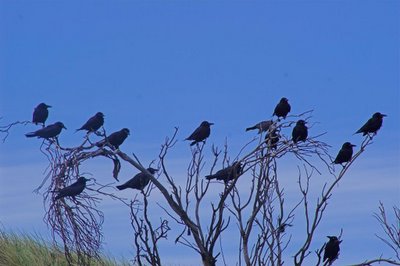

Saturday, December 24, 2005
More from Orielton Lagoon 23/12/05
Bill and I spent the morning at Orielton Lagoon banding Kelp Gull chicks and taking blood samples for DNA studies. Whilst there we also recorded 2 Cape Barren Geese, 55 Golden Plover, 47 Bar-tailed Godwit, 1 Whimbrel, 43 Eastern Curlew and c450 Red-necked Stint. Bill & Els
Tern returns?
Bill and Els saw what they thought was a marsh tern as they drove along Sharkpoint Road (northern side of the Orielton Lagoon), flying up the valley from the direction of the sewage ponds. Investigating further, they found a tern flying back and forth over the pond on the northern side of Brinktop Rd. which they identified as a White-winged (Black) Tern in non breeding plumage. They speculate that it may be the same one seen in November at Barilla Bay.
Friday, December 23, 2005
Marion bay update 22/12/05
Thought I should have a last look at Marion Bay before the onslaught of the Falls Festival, and I came back with mixed emotions. The huge area at the Southern end of the spit had been completely overtopped by recent very high tides and any attempt by the Fairy Terns to breed there would have ended in failure. In fact I did not see a single small tern. Plenty of Crested and a solitary Caspian. Along the main beach were several pairs of Pied Oystercatchers with young, at least 9 Hooded Plovers with no sign of them breeding at present and a flock of around 400 stint with 2 Turnstones. 2 Bar tails made up the list. Perhaps I should own up to having committed a cardinal sin of birders--I forgot my binos--not easy using a cameras tele lens instead. (Hooded Plover; Caspian Tern)
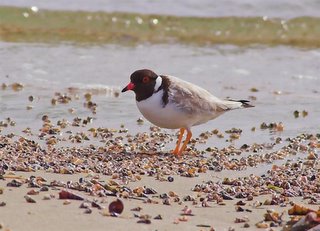



Orford Fairies
Priscilla Park made a recent trip to the Orford Spit to see how the Fairy Terns were getting on. Apparently an earlier breeding attempt had been washed out, but they were now back. Priscilla also remarked on the magnificent sight of the "fairies" hanging in the howling Sou'wester with a brilliant blue sky as their backdrop. I can only add, "where's your camera?"
Tuesday, December 20, 2005
Swampy
This time of year the harriers are hard at it feeding their young and the accompanying photos were taken today at South Arm Neck. Hunting into a stiff breeze they are probably at their most magnificent. They can be seen around much of the state during most of the warmer months, with a few, mainly juveniles, overwintering.

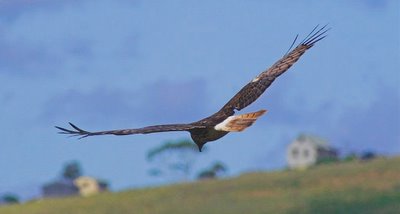
NB The apparent elongated bill on the upper picture is in fact a feather, (click to enlarge photo), the remains of a recent kill.


NB The apparent elongated bill on the upper picture is in fact a feather, (click to enlarge photo), the remains of a recent kill.
Monday, December 19, 2005
Good year for Chats?
"A Bird in the Bush"
Subtitled "A Social History of Birdwatching", written by Stephen Moss, and published by Aurum Press of London, it tells the story through from the early days, largely of the British scene, where it all started, and includes later American involvement. It does dispel my long held and uncharitable view that the reverend gentlemen who seem to have played a major part in its' beginnings, had too much time on their hands! Apparently the countryside in 18th century England was a "no go" area for most people, but the local vicar was off limits to highwaymen, footpads and the like and could wander at will. It goes on to also recount the collectors, taxidermists, oologists, the use of birds feathers in the fashion industry and the more recent improvements in optics, and many other topics. Worth a read.
NB I seem to recall reading that there was a local industry catching birds for the millinery industry. It included, if my memory is correct, catching, by netting, Azure Kingfishers in the creek that runs through Cambridge into Barilla Bay. Perhaps there's someone reading this who can verify that.
NB I seem to recall reading that there was a local industry catching birds for the millinery industry. It included, if my memory is correct, catching, by netting, Azure Kingfishers in the creek that runs through Cambridge into Barilla Bay. Perhaps there's someone reading this who can verify that.
Thursday, December 15, 2005
Orielton Lagoon Update 15/12/05
No sooner than I blog a piece about Orielton than a few more notable birds rear their head. Among the 40+ Curlew and c80 Bar-tailed Godwit are a solitary Whimbrel and the reappearance of the 2 Great Knot. I suspect the best time to find them will be at High Tide at Sorell--appears to be have been around 11am today. The waders are "driven" into Orielton to roost. If you want to see them you WILL need gumboots, and something to wrap them in on returning to your car! Orielton mud is infamous. You will also have to endure the Kelp Gulls, as they have, or are in the course of hatching their young--at a guesstimate there are 50+prs breeding. The Curlew and B/tails normally roost on the waters edge towards the end of the spit that runs out into the lagoon, usually readily seen from the road. A scope would be very useful.
17/12/05 2 Cape Barren Geese have turned up at this site.

17/12/05 2 Cape Barren Geese have turned up at this site.

If you'd only stay still you could be lunch!
Kelp Gull chick with over eager Silver Gull
Kelp Gull chick with over eager Silver Gull
Wednesday, December 14, 2005
In Search of GPs
 There aren't many places in the southern parts of the state where Golden Plover can invariably be found, at least during the warmer months, but Orielton Lagoon is still your best chance. I recently (last weekend) counted 96 there. If you go into the reserve from the Shark Point-Sorell Road end, they can usually be seen in what for many years was called"Tank Corner", that is, close to the golf course on the Midway Point side. As a bonus, you may find the odd Sharptailed Sandpiper embedded in the flock. They are usually fairly difficult to get close too, and if you persist they will take flight and leave the lagoon altogether. If there has been rain during the preceding week,(or you intend to walk close to the water) you'll be advised to wear gum boots! This is one place a scope is a more than useful accoutrement. I have attached some, albeit fairly poor quality, photographs taken on my trip--you can see I couldn't get very close and , in case you're wondering, they were still there when I left.
There aren't many places in the southern parts of the state where Golden Plover can invariably be found, at least during the warmer months, but Orielton Lagoon is still your best chance. I recently (last weekend) counted 96 there. If you go into the reserve from the Shark Point-Sorell Road end, they can usually be seen in what for many years was called"Tank Corner", that is, close to the golf course on the Midway Point side. As a bonus, you may find the odd Sharptailed Sandpiper embedded in the flock. They are usually fairly difficult to get close too, and if you persist they will take flight and leave the lagoon altogether. If there has been rain during the preceding week,(or you intend to walk close to the water) you'll be advised to wear gum boots! This is one place a scope is a more than useful accoutrement. I have attached some, albeit fairly poor quality, photographs taken on my trip--you can see I couldn't get very close and , in case you're wondering, they were still there when I left.
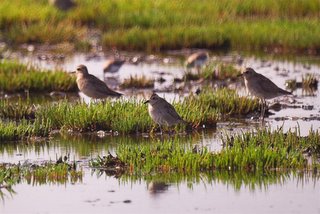
Saturday, December 10, 2005
Much sought after 'tick" for some
Bruce Lord rang me this morning (Saturday) to tell me that a Masked Owl had taken up residence in a Sandy Bay garden and would I be interested in photographing it. I must say my first thoughts were that it would probably be hidden in dense foliage and difficult to see, let alone photograph. However, I certainly don't see Masked Owls that often that I could pass up the opportunity, so armed with camera I set off. I was pleasantly surprised to find the female Masked in the open and photographable, although against a bright sky. Bruce mentioned that he knew of at least one Mainlander who would be on the next aircraft to Tasmania, if he thought the bird would remain here--apparently a much sought after sighting. The bird has been at this residence for at least 10 days. It may have been displaced from a local park that is undergoing major works.
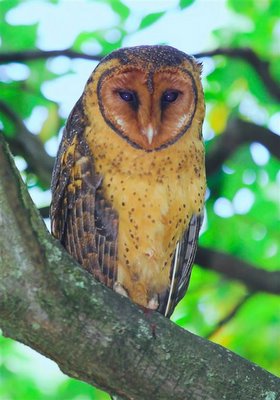



Friday's notables
Just over 1600 Mountain Duck at Lake Dulverton today, along with the Banded Stilt.
There were 4 Blue-billed Duck at the dam at Bothwell.
Nothing else of particular interest ornithologically speaking, but the yellow everlasting daisies and other wildflowers were fantastic. Bill & Els
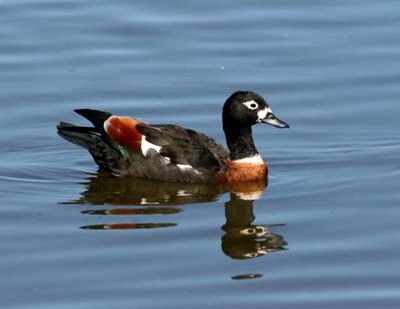
Psst.....all the others are up at Dulverton.
There were 4 Blue-billed Duck at the dam at Bothwell.
Nothing else of particular interest ornithologically speaking, but the yellow everlasting daisies and other wildflowers were fantastic. Bill & Els

Psst.....all the others are up at Dulverton.
Friday, December 09, 2005
Marion Bay Terns
Once the terns choose their spot to colonise, there will be a need to fence the area. If any one is down there--Marion Bay Spit-- in the next few days/week or so, please let me (Priscilla) know if breeding has commenced. Last year illegal 4WDers smashed the fence down and threw the signs into the dunes. Priscilla Park
.....more Frogmouths.
Some of my family visited Taroona recently for a Scouts outing, and came back boasting about the Tawny Frogmouths they'd seen. Up until then we hadn't added them to our Tassie list, though we had seen lots on the Mainland.
My wife and I went to check them out, and sure enough, this little family of Frogmouths was still there--even on the same branch! The family were roosting in a small gum tree in the grounds of the Taroona Fire Station, and were low enough for easy photography.
'Mum and Dad' were trying their best to look like dead branches, but the 'kids' just didn't seem to have any idea. They were far more inquisitive about intruders, looking back at those watching them. Just as well the parents kept them hemmed in to keep a close, if almost closed, eye on them. John Tongue.
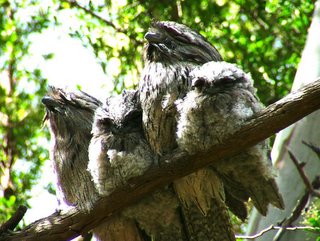

My wife and I went to check them out, and sure enough, this little family of Frogmouths was still there--even on the same branch! The family were roosting in a small gum tree in the grounds of the Taroona Fire Station, and were low enough for easy photography.
'Mum and Dad' were trying their best to look like dead branches, but the 'kids' just didn't seem to have any idea. They were far more inquisitive about intruders, looking back at those watching them. Just as well the parents kept them hemmed in to keep a close, if almost closed, eye on them. John Tongue.


Wednesday, December 07, 2005
New Sightings 6/12/05
Bill reports that there are now 2 Sanderlings at Marion Bay as well as the previously reported waders. He also says that there may be at least one nest in the area around the Spit, as there was one bird acting aggressively and that the remaining 25 Fairy and 1 Little Terns were favouring the Spit area. I noted that several of the terns seemed interested in an area of shell grit near the Spit end and that close by there was a Pied Oystercatcher nest. Any one venturing down there should exercise caution in this vicinity.
There has been a report of 15 Japanese Snipe at Lake Dulverton, and should be worth following up.
There has been a report of 15 Japanese Snipe at Lake Dulverton, and should be worth following up.
Tuesday, December 06, 2005
Marion Bay revisited again! 6/12/05
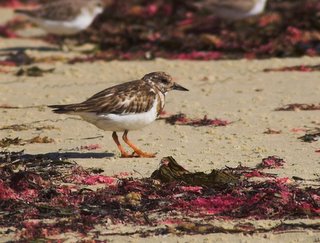
 Unbeknown to me, Bill & Els had visited here the previous day. However my interest was still to find some 'hoodies' to photograph. I found most of the same things as B&E, but missed out on the Sanderling. On the credit side, I did see the c70 Bar-tails. There was a strong onshore wind making photography difficult, and the photographs of the hoodies were somewhat less than I was hoping for, but I was luckier with the, turnstones, plover and tern. Also on the ocean beach were c200 Red-necked Stint feeding among the seaweed, and a beachwashed Gannet , Diving Petrel and 25+ Short-tails.
Unbeknown to me, Bill & Els had visited here the previous day. However my interest was still to find some 'hoodies' to photograph. I found most of the same things as B&E, but missed out on the Sanderling. On the credit side, I did see the c70 Bar-tails. There was a strong onshore wind making photography difficult, and the photographs of the hoodies were somewhat less than I was hoping for, but I was luckier with the, turnstones, plover and tern. Also on the ocean beach were c200 Red-necked Stint feeding among the seaweed, and a beachwashed Gannet , Diving Petrel and 25+ Short-tails.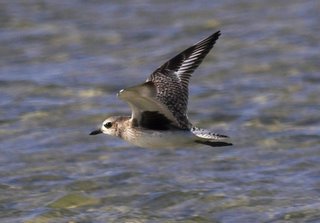
 The Grey Plover has these black 'underarm' markings, seen in flight, which are diagnostic of the Grey vs. Golden Plovers.
The Grey Plover has these black 'underarm' markings, seen in flight, which are diagnostic of the Grey vs. Golden Plovers.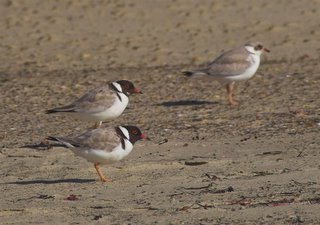
The 3 Hooded Plovers seen here were part of a small group of 5 birds, 4 adult and one juvenile on the main beach.
Marion Bay revisited 5/12/05
We went to Marion Bay again, and the first bird of note was a solitary Sharp-tailed Sandpiper on the marsh in the centre of the trotting track by the causeway. Also present was c60 Pied Oystercatcher, one carrying 3 colour bands on one leg, but too far away to determine the combination.
Could it be that the increase in the numbers of P.O.s at Lauderdale and South Arm are mainland birds. A considerable number of colour banded birds have been seen on King Island. If observers have the chance to read the colour combination of this or other birds, it could prove interesting.
Out on the Spit there were other good finds in the form of a Grey Plover, a single Sanderling and 26 fairy Terns. Along the ocean beach a lot more seaweed than usual had attracted 3 Ruddy Turnstone, which we almost walked past before they got up and walked a little further up the beach to allow us to walk by. Only 2 Bar-tails were located, with none found elsewhere in the bay.
A further search for the 3 Canada Geese recorded by Andrew and Cynthia Meyles in the middle of last month, between Dunalley and Marion Bay, proved unsuccessful. (Having seen the impact that large numbers of Canada Geese have had overseas, I wish them a short life!ed) Bill & Els
NB Bill tells me the "Canada Geese", turned out to be Swan or Chinese Geese--a little premature in wishing them short lives!
Could it be that the increase in the numbers of P.O.s at Lauderdale and South Arm are mainland birds. A considerable number of colour banded birds have been seen on King Island. If observers have the chance to read the colour combination of this or other birds, it could prove interesting.
Out on the Spit there were other good finds in the form of a Grey Plover, a single Sanderling and 26 fairy Terns. Along the ocean beach a lot more seaweed than usual had attracted 3 Ruddy Turnstone, which we almost walked past before they got up and walked a little further up the beach to allow us to walk by. Only 2 Bar-tails were located, with none found elsewhere in the bay.
A further search for the 3 Canada Geese recorded by Andrew and Cynthia Meyles in the middle of last month, between Dunalley and Marion Bay, proved unsuccessful. (Having seen the impact that large numbers of Canada Geese have had overseas, I wish them a short life!ed) Bill & Els
NB Bill tells me the "Canada Geese", turned out to be Swan or Chinese Geese--a little premature in wishing them short lives!
Peter Murrell Reserve--Coffee Creek 4/12/05
The Tawny Frogmouth nest that Tas Boskell told us about was found and photographed (see pic) . Tas had mentioned that it was to be found at the East end of the dam wall as you cross the little creek leading out of the dam nearest the car park. The mate of the brooding bird was sitting within 3 metres of the track and only briefly opened one eye. The large chick did momentarily put on a display of yawning, but that was it as far as major action was concerned! Bill & Els
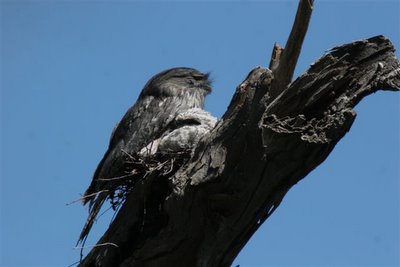
Peter Murrell reserve is situated at Kingston just to the South of the roundabout just past the Antarctic Div HQ. It's a good spot to find endemics.

Peter Murrell reserve is situated at Kingston just to the South of the roundabout just past the Antarctic Div HQ. It's a good spot to find endemics.
Saturday, December 03, 2005
Iron Pot and Betsy Island 2/12/05
 Had a great day visiting the Iron Pot and circumnavigating Betsy Island. This year the Black-faced Cormorants and Silver Gulls have all moved fron the Iron pot and Little Betsy Is.. The Black-faced Cormorants breeding colonies are on the East face of 'Big' Betsy, where there are over 800 adults and young in 3 colonies on cliffs painted white with guano. The Silver Gulls are on the South eastern corner of the island overlooking Little Betsy.
Had a great day visiting the Iron Pot and circumnavigating Betsy Island. This year the Black-faced Cormorants and Silver Gulls have all moved fron the Iron pot and Little Betsy Is.. The Black-faced Cormorants breeding colonies are on the East face of 'Big' Betsy, where there are over 800 adults and young in 3 colonies on cliffs painted white with guano. The Silver Gulls are on the South eastern corner of the island overlooking Little Betsy.One pair of Caspian Terns are nesting on the Iron Pot--the only species of tern breeding there, though there are both Pacific and Kelp Gulls breeding there and look to have a firm foothold.
The Islands are particularly beautiful at the moment with pigface flowering over extensive areas. Bill & Els
NB The Iron Pot is at the mouth of the Derwent River and the Betsy Islands are situated to the East lying off Goat Bluff and Black Jack Rocks.
Digital photography
Not sure how much readers know about digital photography, no doubt it ranges from a lot to no interest. I don't claim to be an expert, but I do have a fair idea about equipment needed, what you can expect to achieve and not least, what it might cost. On that subject, if you are or have been using a film based Single Lens Reflex (SLR) you're half way there. If readers are interested, I'll blog something or if you add comments below, I'll address those issues. If you want something more personalised, I'll e-mail or even phone! Look forward to your comments.
If you're already a digital photographer, but like me still in the learning stage, you might find the post on "Illinois Birds" (Link on this page) about the merits of using RAW and Raw Shooter interesting.
If you're already a digital photographer, but like me still in the learning stage, you might find the post on "Illinois Birds" (Link on this page) about the merits of using RAW and Raw Shooter interesting.
Hoodies at Marion Bay
Sadly the numbers of Hoodies at Marion Bay have declined. There used to be 4prs at the entrance from the car park, now only one. I believe there are 2 prs at the southern end and odd ones going north. They will have to contend with the Falls Festival! Despite the fact that dogs/owners have to stay within the dog exercise area, last year very little control. [evidence of dogs having been in "forbidden" zone on 28/11/05 ed.] Pity there aren't more decomposing whales--might keep them off the beach! Priscilla P.
Friday, December 02, 2005
Gould's Lagoon 2/12/05
 Gould's Lagoon is certainly worth a trip anytime, and at the moment one of the 'signature' birds, the Reed Warbler is particularly active and vocal. On arrival fairly early morning, the sound of Reed Warblers calling was the first sound to greet me. I couldn't see any of the several birds calling,
Gould's Lagoon is certainly worth a trip anytime, and at the moment one of the 'signature' birds, the Reed Warbler is particularly active and vocal. On arrival fairly early morning, the sound of Reed Warblers calling was the first sound to greet me. I couldn't see any of the several birds calling,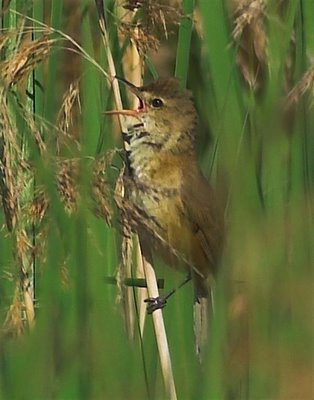
but patience was eventually rewarded. Admittedly most of the views were fleeting, but I managed to take a few shots, seen here. Also present were Coot, Chestnut Teal, Black Duck, Swamphen and Native Hen. Heard calling, but not sighted were several Little Grassbirds. Gould's is often worth at least a passing visit, in the past it has managed to attract such unlikely species as Black-tailed Native Hen and Little Ringed Plover. I can particularly remember the plover, as Mike Newman rang me up to tell me that it had been seen there. However it was the 1st of April and it took him a long time to convince me it wasn't an April Fool's joke!! The Shore Bird Study Group unsuccessfully attempted to mist net it. Other species present at times are a list of duck and crakes. A little more ominous, I feel, is the presence of a pair of nesting Kelp Gulls. They presently have 2 young, being reared on the top of a duck nesting box.
All together I recorded 26 species in approx. an hour. I have appended a couple of additional shots of the reed warbler.


Who's watching who?
 Bill W. had told me he has a hide at Prosser's Dam, so returning from a recent trip (2/12) I decided to have a look at it out of curiosity. As I neared the dam, screened from my view by young trees, I noticed the unmistakable outline of a Sea Eagle, sitting in the top of a dead tree, usually frequented by cormorants. Driving a little further and the hide came into view--situated at the base of the self same dead tree! I assume Bill wasn't in it, and even if he had been I doubt whether he would have been aware of the eagle.
Bill W. had told me he has a hide at Prosser's Dam, so returning from a recent trip (2/12) I decided to have a look at it out of curiosity. As I neared the dam, screened from my view by young trees, I noticed the unmistakable outline of a Sea Eagle, sitting in the top of a dead tree, usually frequented by cormorants. Driving a little further and the hide came into view--situated at the base of the self same dead tree! I assume Bill wasn't in it, and even if he had been I doubt whether he would have been aware of the eagle. While in the area I took the White Kangaroo Rd, to see if I could find any sign of the Masked Woodswallows reported there by Cynthia and Andrew Meyles on the 19th of last month. I did see a 'dusky', but no sign of the masked. Well worth keeping an eye out for these, I doubt whether they've left the area.
While in the area I took the White Kangaroo Rd, to see if I could find any sign of the Masked Woodswallows reported there by Cynthia and Andrew Meyles on the 19th of last month. I did see a 'dusky', but no sign of the masked. Well worth keeping an eye out for these, I doubt whether they've left the area.
Subscribe to:
Posts (Atom)




